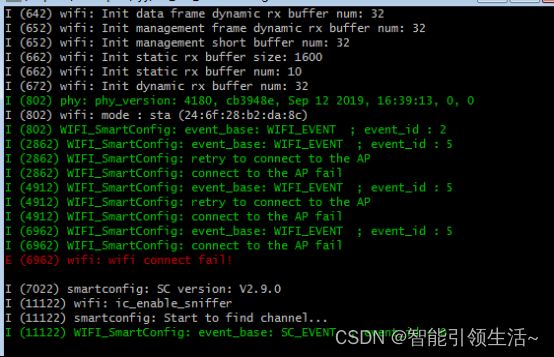ESP32 IDF开发 应用篇⑯ SmartConfig一键配网
ESP32 IDF开发 应用篇⑯ SmartConfig一键配网
-
- 1、博主写这篇技术文章的目的:
- 2、概述
- 3、SmartConfig 特点
- 4、SmartConfig API的介绍
- 5、软件设计
- 6、实例
别迷路-导航栏
快速导航找到你想要的(文章目录)
此篇文章如果对你有用,请点赞收藏,您的支持就是博主坚持的动力。
1、博主写这篇技术文章的目的:
(1)、了解 什么是SmartConfig;
(2)、SmartConfig的编程方法;
2、概述
在前面章节连接wifi我们都是直接在程序中写入ssid和password,但在实际项目中是不允许直接写入代码中。
当你拿到一块WiFi模块,如果需要连上网络,则需要将SSID名称、密码设置到模块当中。一般有几种方式:
(1)、一种就是通过串口接到输入设备,通过串口输入AT指令(SSID名称和密码),但是前提是该模块本身烧入了AT固件,很明显不符合Arduino core for ESP32开发;
(2)、一种就是设备提供一个AP热点,手机连上这个热点,然后通过手机把家里的WiFi的SSID和密码配置到设备上,最后手机再切换回家里的WiFi(这里就是博主后面会讲到的Web配网)。这种配网成功率可以说是100%,缺点是配置过程复杂,做出的产品不易操作。
(3)、SmartConfig 模式,采用 UDP 广播模式(UDP 接收 IP 地址是 255.255.255.255)。WiFi设备先 scan 环境下 AP,得到 AP 的相关信息,如工作的 channel,然后配置 WiFi 芯片工作在刚才 scan 到的 channel 上去接收 UDP 包,如果没有接收到,继续配置工作在另外的 channel 上,如此循环,直到收到 UDP 包为止。随意此种办法的致命缺点是成功率只有 70%,而且有些路由器不支持;优点显而易见,一键完成。
3、SmartConfig 特点
SmartConfig 又名快连,当前设备在没有和其他设备建立任何实际性通信链接的状态下,
一键配置该设备接入 WIFI。
4、SmartConfig API的介绍
这里介绍大部分SmartConfig库的使用更详细的请参考:
更多API 参考esp-idf\components\esp_wifi\include\esp_smartconfig.h
#include “esp_smartconfig.h”
SmartConfig使用大体分为三步:
(1)、设置SmartConfig的协议类型
/**
* @brief 设置SmartConfig的协议类型。
*
* @注意如果用户需要设置SmartConfig类型,请在调用之前进行设置
* esp_smartconfig_start。
*
* @参数类型从smartconfig_type_t中选择。
*
* @return
*-ESP_OK:成功
*-其他:失败
*/
esp_err_t esp_smartconfig_set_type(smartconfig_type_t type);
(2)、启动SmartConfig配置ESP设备以连接AP。
/**
* @brief 启动SmartConfig,配置ESP设备以连接AP。 您需要通过手机APP广播信息。
*设备从空中嗅探包含目标AP的SSID和密码的特殊数据包。
*
* @注意1.可以在站点或softAP站点模式下调用此API。
* @注意2.无法完成之前无法两次调用esp_smartconfig_start,请致电
* esp_smartconfig_stop首先。
*
* @param config指向smartconfig的指针开始配置结构
*
* @return
*-ESP_OK:成功
*-其他:失败
*/
esp_err_t esp_smartconfig_start(const smartconfig_start_config_t *config);
(3)、停止SmartConfig
/**
* @brief 停止SmartConfig,释放esp_smartconfig_start占用的缓冲区。
*
* @attention 无论是否成功连接到AP,都应调用此API以释放它
* smartconfig_start占用的内存。
*
* @return
*-ESP_OK:成功
*-其他:失败
*/
esp_err_t esp_smartconfig_stop(void);
其他API函数
/**
* @brief 设置SmartConfig进程的超时时间。
*
* @注意时间从SC_STATUS_FIND_CHANNEL状态开始。 如果超时,SmartConfig将重新启动。
*
* @param time_s范围15s〜255s,偏移:45s。
*
* @return
*-ESP_OK:成功
*-其他:失败
*/
esp_err_t esp_esptouch_set_timeout(uint8_t time_s);
/**
* @brief 设置SmartConfig模式。 默认普通模式。
*
* @注意1.请在API esp_smartconfig_start之前调用它。
* @注意2.快速模式下有相应的APP(电话)。
* @注意3.两种模式兼容。
*
* @param enable false-disable(默认); 启用
*
* @return
*-ESP_OK:成功
*-其他:失败
*/
esp_err_t esp_smartconfig_fast_mode(bool enable);
5、软件设计
①、初始化设置wifi sta模式注册wifi联网回调函数
ESP_ERROR_CHECK(esp_event_handler_register(WIFI_EVENT, ESP_EVENT_ANY_ID, &event_handler, NULL));
ESP_ERROR_CHECK(esp_event_handler_register(IP_EVENT, IP_EVENT_STA_GOT_IP, &event_handler, NULL));
②、注册SmartConfig回调函数
ESP_ERROR_CHECK(esp_event_handler_register(SC_EVENT, ESP_EVENT_ANY_ID, &event_handler, NULL) );
事件SC_EVENT在SmartConfig中已经定义:wifih回调事件参考:
【ESP32 IDF开发 应用篇⑬ 连接Wifi回调函数esp_event_handler_register专题】
/** @brief smartconfig 基本event声明 */
ESP_EVENT_DECLARE_BASE(SC_EVENT);
③、等待wifi连接失败,创建SmartConfig任务事件,并且启动SmartConfig
ESP_ERROR_CHECK( esp_smartconfig_set_type(SC_TYPE_ESPTOUCH) );
smartconfig_start_config_t cfg = SMARTCONFIG_START_CONFIG_DEFAULT();
ESP_ERROR_CHECK( esp_smartconfig_start(&cfg) );
④、然后打开手机esptouch APP输入ssid和password点击连接连接,esp32调用回调函数获得手机端广播来的ssid和password,保存在nvs中并连接
else if (event_base == SC_EVENT && event_id == SC_EVENT_GOT_SSID_PSWD) //获得SSID 和 password
{
。。。
}
在于手机交互过程中会发生多个事件:
/** Smartconfig event 声明 */
typedef enum {
SC_EVENT_SCAN_DONE, /*!< ESP32 station smartconfig 已完成扫描AP */
SC_EVENT_FOUND_CHANNEL, /*!< ESP32 station smartconfig 找到了目标AP的信道 */
SC_EVENT_GOT_SSID_PSWD, /*!< ESP32 station smartconfig 得到了SSID和密码 */
SC_EVENT_SEND_ACK_DONE, /*!< ESP32 station smartconfig 已发送回手机 */
} smartconfig_event_t;
⑤、最后设置成功之后应答手机端触发应答事件,并且关闭SmartConfig
else if (event_base == SC_EVENT && event_id == SC_EVENT_SEND_ACK_DONE)
{
。。。。
}
esp_smartconfig_stop();
⑥、重启之后系统直接从nvs中读取ssid和password直接链接wifi ,不用每次都使用SmartConfig配置。
6、实例
复制idf_wifi sta工程改名字为 idf_wifi_SmartConfig(因为本例程是基于idf_wifi sta)即可 文件名字改为 idf_wifi_SmartConfig.C makefile文件也改成 PROJECT_NAME := idf_wifi_SmartConfig即可,然后复制一下代码测试。
/**********************************************************************
* 文件名: idf_wifi_udp.c
* 创建人:
* 创建日期:
* 修改人:
* 修改日期:
* 版本号: V1.1
* 备注:
* 公司:
********************************************************************/
#include 7、调试结果
首先下载EspTouch app软件
下载链接:链接:https://pan.baidu.com/s/1Ds_cKtzL0CVbLXCKltxqHA
提取码:m5zf
运行代码,打开EspTouch


所有文章源代码:https://download.csdn.net/download/lu330274924/88518092
